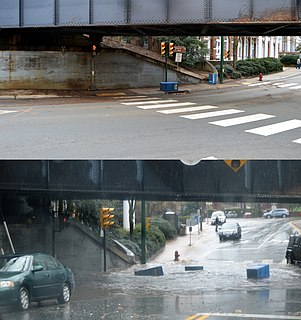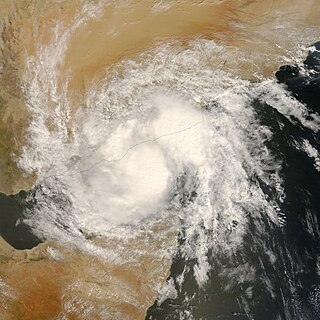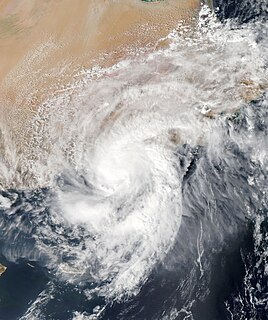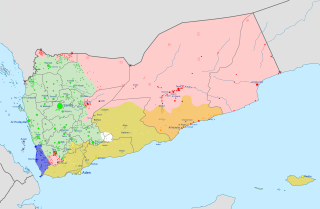
Oman is a country situated in Southwest Asia, bordering the Arabian Sea, Gulf of Oman, and Persian Gulf, between Yemen and the United Arab Emirates (UAE).

The Cooperation Council for the Arab States of the Gulf, originally known as the Gulf Cooperation Council, is a regional intergovernmental political and economic union consisting of all Arab states of the Persian Gulf except Iraq. Its member states are Bahrain, Kuwait, Oman, Qatar, Saudi Arabia, and the United Arab Emirates. The Charter of the Gulf Cooperation Council was signed on 25 May 1981, formally establishing the institution.

A flash flood is a rapid flooding of low-lying areas: washes, rivers, dry lakes and basins. It may be caused by heavy rain associated with a severe thunderstorm, hurricane, tropical storm, or meltwater from ice or snow flowing over ice sheets or snowfields. Flash floods may occur after the collapse of a natural ice or debris dam, or a human structure such as a man-made dam, as occurred before the Johnstown Flood of 1889. Flash floods are distinguished from regular floods by having a timescale of fewer than six hours between rainfall and the onset of flooding. The water that is temporarily available is often used by plants with rapid germination and short growth cycles and by specially adapted animal life.

Qaboos bin Said Al Said is the Sultan of Oman. He rose to power after overthrowing his father, Said bin Taimur, in a palace coup in 1970. He is a 14th-generation descendant of the founder of the Al Bu Sa'id dynasty. He is the longest serving Arab leader, having held the office since 1970.

The Oman national football team is the national team of Oman that has represented Oman in international competitions since 1978. Although the team was officially founded in 1978, the squad was formed long before, and a proper football association was formed only in December 2005. The team is governed by the Oman Football Association.

Oman proper may refer to Al Hajar Mountains, and the Imamate of Oman refers to a historical area within the present-day Sultanate of Oman. It lay inland from Muscat beyond the Jibal Al-Akhdar, and was centered on the city of Nizwa in the area of the current region of Ad-Dakhiliyah. Along with Muscat and Dhofar, it was a constituent part of the Sultanate of Muscat and Oman, but with the 1970 coup d'état, the term 'Oman' alone was applied to the entire country.

Al Buraimi is a governorate of Oman which was split from the Ad Dhahirah Region. Until October 2006, the area was part of Ad Dhahirah Region. At this time, the new governorate was created from the Wilayats (Provinces) of Al Buraymi and Mahdah. A third wilayat, As-Sunaynah, was created from parts of the two.

In October 2008, the remnants of a tropical cyclone caused extensive damage in Yemen, a poor country on the southern tip of the Arabian Peninsula. The storm, officially known as Deep Depression ARB 02, was the sixth tropical cyclone of the 2008 North Indian Ocean cyclone season, and the second tropical cyclone in the Arabian Sea that year. It formed on October 19 off the west coast of India from the same broader system that spawned a storm in the southern Indian Ocean. Moving generally westward, the depression failed to intensify much, reaching maximum sustained winds of only 55 km/h (35 mph). It was no longer classifiable as a tropical depression by October 23, and later that day, its remnants struck near Ash Shihr in eastern Yemen.

The 1977 Oman cyclone was the deadliest tropical cyclone on record to strike Oman. The storm formed off the west coast of India in the Arabian Sea, and curved westward to reach peak winds of 110 km/h (70 mph). The storm struck Masirah Island and later southern Oman on June 13, before dissipating the next day over Saudi Arabia. Producing wind gusts to 230 km/h (140 mph), the storm was the strongest cyclone on record to hit the Arabian Peninsula until Cyclone Gonu hit in 2007. About 95% of Marisah Island was damaged by the strong winds, including much of the military base. The cyclone dropped 430.6 mm (16.95 in) of rainfall over a 24 period on Marisah, which was the highest daily total in the country as of 2003. Overall, the storm killed at least 105 people and left 50,000 homeless.
Jebel Akhdar War or Jebel Akhdar rebellion broke out in 1954 and again in 1957 in Oman, as an effort by Imam Ghalib Bin Ali to protect the Imamate of Oman lands from the Sultan Said bin Taimur; the rebellion was supported by the Kingdom of Saudi Arabia and Egypt. The war continued until 1959, when the British armed forces intervened on the Sultan's side, helping him win the war.

Cyclonic Storm Keila was the first named storm of the 2011 North Indian Ocean cyclone season. A weak system for much of its duration, Keila developed in the western Arabian Sea in late October 2011, amid an area of marginally favorable conditions. On November 2, it briefly organized enough to be classified as a cyclonic storm, which has maximum sustained winds of at least 65 km/h (40 mph). Given the name Keila by the India Meteorological Department (IMD), the storm quickly moved ashore southern Oman near Salalah, and weakened while meandering over the country. The remnants soon after moved offshore, dissipating on November 4.

The Yemeni Civil War is an ongoing conflict that began in 2015 between two factions: the internationally recognized Yemeni government, led by Abdrabbuh Mansur Hadi, and the Houthi armed movement, along with their supporters and allies. Both claim to constitute the official government of Yemen. Houthi forces controlling the capital Sana'a, and allied with forces loyal to the former president Ali Abdullah Saleh, have clashed with forces loyal to the government of Abdrabbuh Mansur Hadi, based in Aden. Al-Qaeda in the Arabian Peninsula (AQAP) and the Islamic State of Iraq and the Levant have also carried out attacks, with AQAP controlling swathes of territory in the hinterlands, and along stretches of the coast.

A military intervention was launched by Saudi Arabia in 2015, leading a coalition of nine countries from the Middle East and Africa, in response to calls from the internationally recognized pro-Saudi president of Yemen Abdrabbuh Mansur Hadi for military support after he was ousted by the Houthi movement due to economic and political grievances, and fled to Saudi Arabia. Code-named Operation Decisive Storm, the intervention is said to be in compliance with Article 2(4) of the UN Charter by the international community; this has been contested by some academics. The intervention initially consisted of a bombing campaign on Houthi rebels and later saw a naval blockade and the deployment of ground forces into Yemen. The Saudi-led coalition has attacked the positions of the Houthi militia, and loyalists of the former President of Yemen, Ali Abdullah Saleh, allegedly supported by Iran. The Houthis who had pressured Mansur Hadi for reforms, say that they took power through a popular revolt and are defending Yemen from a western backed invasion. The Saudi-led bombings soon expanded to most of Western Yemen including civilian targets and was followed by UAE-led deployment of ground forces in the South.
The 2018 East Africa Floods are an ongoing natural disaster in Kenya, Ethiopia, Uganda, Rwanda, Somalia, Djibouti, and Burundi affecting millions of people. They began when excessive rains began falling in March 2018 following a year of severe drought and are still ongoing as of June 2018, leading to massive flooding, landslides, and the failure and overflow of several dams. Record rainfall was recorded in several areas, surpassing various records set during the 1950's and during the 1997–98 El Niño event. Nearly 500 people have lost their lives while hundreds of thousands of others have been displaced.

Extremely Severe Cyclonic Storm Mekunu was the strongest storm to strike Oman's Dhofar Governorate since 1959. The second named storm of the 2018 North Indian Ocean cyclone season, Mekunu developed out of a low pressure area on May 21. It gradually intensified, passing east of Socotra on May 23 as a very intense tropical cyclone. On May 25, Mekunu reached its peak intensity on May 25. The India Meteorological Department estimated 10 minute sustained winds of 175 km/h (110 mph), making Mekunu an extremely severe cyclonic storm. The American-based Joint Typhoon Warning Center estimated slightly higher 1 minute winds of 185 km/h (115 mph). While near peak intensity, Mekunu made landfall near Raysut, Oman. The storm rapidly weakened over land.














